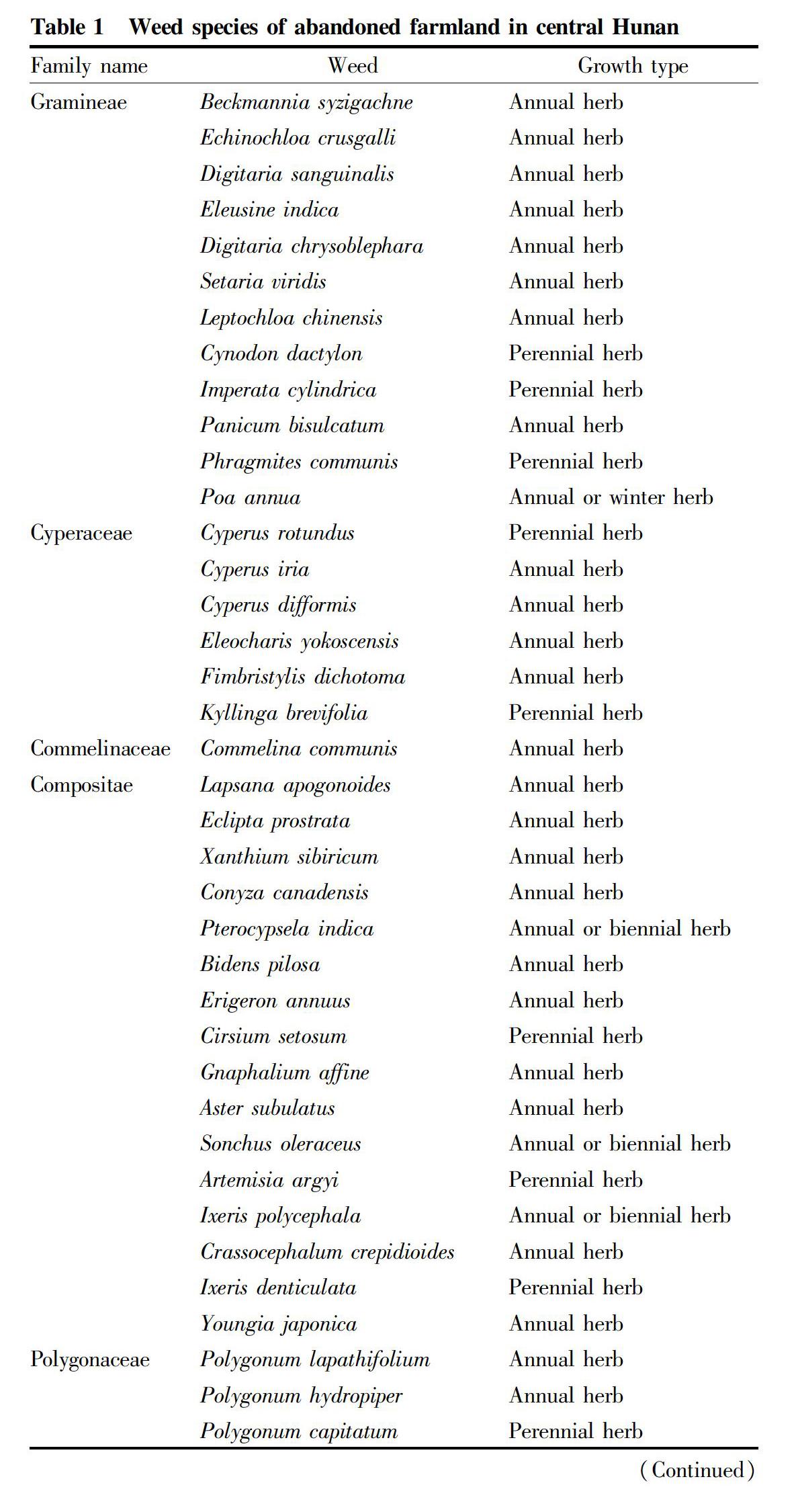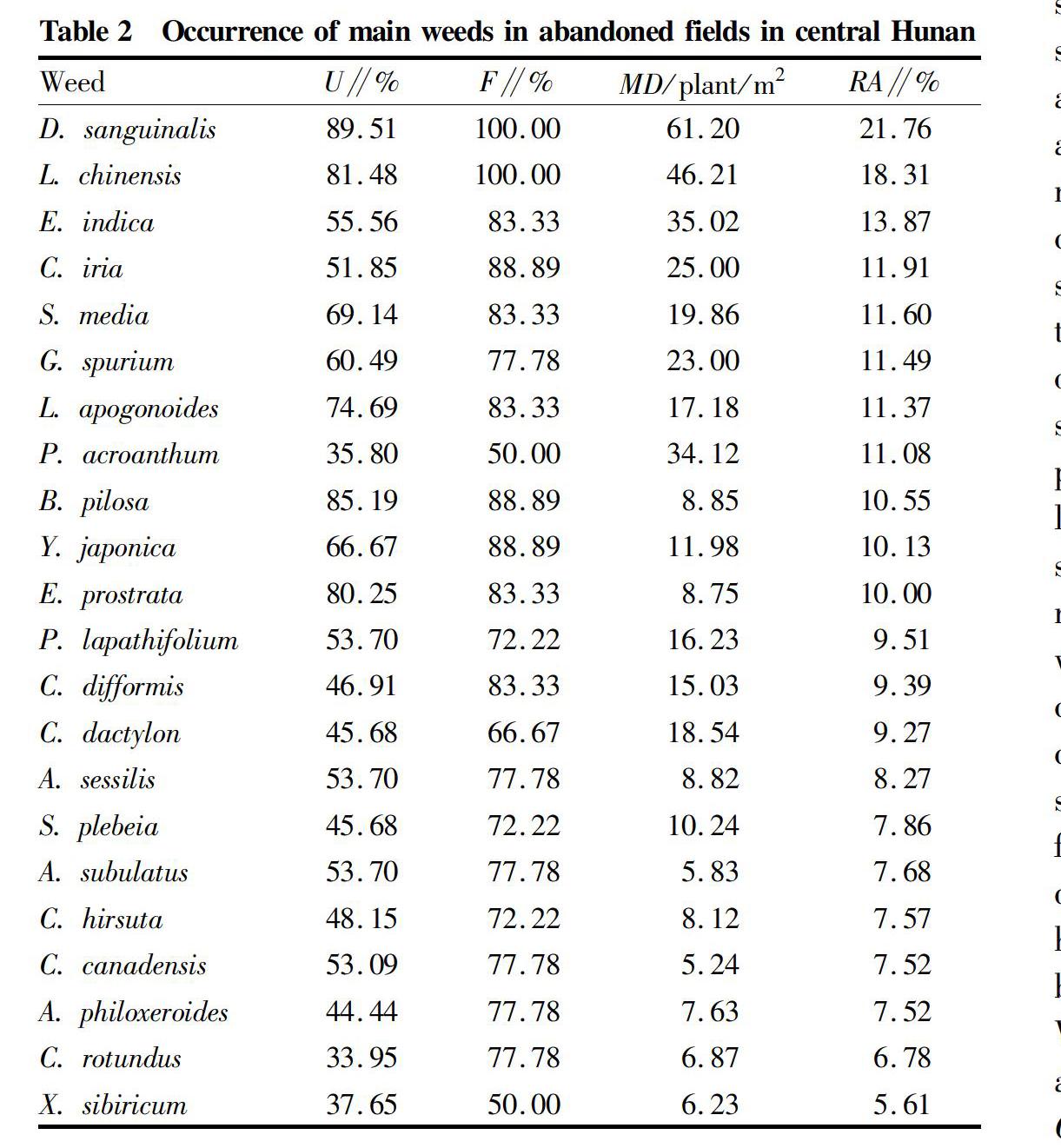Occurrence and Control of Weeds in Abandoned Fields in Central Hunan
Yunyun ZHOU Shunli XIAO Chenzhong JIN Xiu LIU Jun PAN Kuojie XIAO Qiuyuan DUAN



Abstract [Objectives] This study was conducted to clarify the occurrence of weeds, and give relevant comprehensive control suggestions accordingly.
[Methods]The species and community characteristics of weeds in abandoned rice fields in central Hunan were investigated and analyzed.
[Results] There were 75 species of weeds in the abandoned farmland in central Hunan, belonging to 66 genera, 27 families. Among them, 22 species had a relative abundance of more than 5%. According to the different water environments of abandoned fields, there were differences in the types and structures of weeds. They succeeded to wetland vegetation types and dryland vegetation types respectively. Species grown in the original farmland still exist in abandoned fields, but they were mainly invaded by field weeds, such as Digitaria sanguinalis, Eleusine indica, Panicum acroanthum, Bidens pilosa, and Xanthium sibiricum.
[Conclusions]This study lays a foundation for fully guaranteeing the actual results of re-cultivation of abandoned land in rural areas.
Key words Central Hunan; Abandoned fields; Weeds; Integrated control
Received: December 4, 2020 Accepted: February 5, 2021
Supported by Scientific Research Fund of Hunan Provincial Education Department (18B461); Scientific Research Fund of Hunan Provincial Science and Technology Innovation Plan Project (2019NK4170).
Yunyun ZHOU (1986-), Female, P. R. China, major in wildlife resources management. 67547204@qq.com.
*Corresponding author. E-mail: 532479626@qq.com.
With the onset of urbanization, the main laborers are going out to work, and the problem of leaving land uncultivated in many rural areas has been widespread at present because of decreased rural consumption of grains, low efficiency of grain production, lagging development of commercial grain industry, and poor agricultural infrastructure. The abandoned fields are widely distributed with many types and large area. As a result, there are about 50%-90% of winter fallow fields formed due to the idleness and abandonment of winter farmland. In addition to winter fallow fields, there are also fallow fields in different seasons, farmlands fallow all year round, and even long-term abandoned farmland[1]. The abandonment of arable land has caused a decline in the production capacity of grains in the south. Now "transporting grains from the south to the north" has been changed to "transferring the north grains to the south". Long-term uncultivated land has also caused the decline of soil fertility and increased abandonment problems, which has a greater impact on Chinas agriculture. Meanwhile, policies and measures for re-cultivation of abandoned land have emerged in various places, striving to ensure that suitable arable land should be cultivated, and sticking to the red line of 1.8 billion mu of arable land. In this study, the types and community characteristics of weeds in abandoned fields in central Hunan were investigated and analyzed to clarify the occurrence of weeds, scientifically and rationally screen agrochemicals based on the characteristics of weeds, and provide relevant comprehensive prevention and control recommendations, aiming to lay a foundation for ensuring that practical results can be achieved in the re-cultivation of abandoned land.
Materials and Methods
Investigation background and methods
In September-November 2019 and September-October 2020 in Loudi City, Shaoyang City, Xiangtan City and other cities and counties in central Hunan, a fixed-site investigation and a random general investigation were conducted[2]. The entire survey involved 18 sample sites, 162 sample plots in total, and each investigation site had an area not less than 1 334 m2. The inverted "W" 9-point sampling method was adopted. The investigation area in each plot was 1 m2, in which the types of weeds were recorded and samples were collected. The name, quantity, height and other indicators of weeds were recorded, and the quantity of weeds was expressed by the number of weed stems. The collected samples were classified and identified with reference to Chinese Weeds[3], Chinese Farmland Weed Color Atlas[4] and Weed Science[5].
Calculation method and data analysis
According to the investigation results, the field uniformity (U), field frequency (F), field density (MD), relative uniformity (RU), relative frequency (RF), relative field density (RD) and relative abundance (RA) and other indicators were calculated according to the method of Zhang et al.[6]. Excel 2019 was used for data processing and analysis.
Results and Analysis
Weed species of abandoned farmland in central Hunan
In this investigation of weeds in abandoned rice fields in central Hunan, there were 75 species of weeds, belonging to 66 genera, 27 families. Among them, Compositae weeds were the most, including 16 species, accounting for 8% of the total; Gramineae ranked second, including 12 species; there were 6 kinds of weeds belong to the Cyperaceae; 5 species were of Scrophulariaceae and Polygonaceae; 3 species belonged to Euphorbiaceae and Amaranthaceae; each of Cruciferae, Onagraceae, Lythraceae, Lamiaceae, and Leguminosae included 2 species; and 1 species was included in each of Commelinaceae, Phytolaccaceae, Rubiaceae, Acanthaceae, Moraceae, Rosaceae, and Umbelliferae (Table 1). Among them, there were 19 species of monocotyledonous plants, belonging to 16 genera, 3 families, and 54 species of dicotyledonous plants were observed, belonging to 49 genera, 22 families. In terms of growth types, there were 42 species of annual herbs, accounting for 56% of the total.
Occurrence of main weeds in abandoned fields in central Hunan
The investigation and analysis results showed that there were abundant weed species in central Hunan, of which 17 species had a relative abundance of more than 10%, and 22 species had a relative abundance of more than 5%. Gramineae and Cyperaceae weeds such as D. sanguinalis, L. chinensis and C. iria are common in abandoned fields.
According to the ecological environment difference of abandoned farmland, the distribution of plant species is different. Most of the abandoned fields mainly showed two community structures: ① Gramineae and Cyperaceae weeds were the dominant species, such as L. chinensis, D. sanguinalis, E. indica, P. acroanthum, and C. iria; and ② the dominant species were broadleaf weeds of Compositae, such as invasive weeds B. pilosa and X. sibiricum. In some abandoned fields with a better water environment, P. communis, T. orientalis, and I. cylindrica were the dominant species, and weeds such as E. yokoscensis, K. brevifolia, and P. hydropiper grew more. In some abandoned fields, E. hirsutum grew more. With the increase in the number of uncultivated years, small trees such as B. papyrifera appeared in the abandoned fields.
Conclusions and Discussion
There were 75 species of weeds in abandoned farmland in central Hunan, belonging to 66 genera, 27 families. There were rich species, among which Compositae, Gramineae and Cyperaceae weeds were more diverse and widely distributed. Weeds that commonly grow in rice fields, such as E. crusgalli, L. chinensis, P. annua and C. communis still exist in abandoned fields, but they were mainly invaded by field weeds, including Gramineae and Cyperaceae weeds such as D. sanguinalis, E. indica, P. acroanthum, and C. iria, and invasive alien weeds with strong reproductive ability such as B. pilosa and X. sibiricum. In some areas, there were a large number of E. hirsutum and T. orientalisin abandoned fields. According to the different water environments of abandoned fields, there were differences in the types and structures of weeds. They succeeded to wetland vegetation types and dryland vegetation types respectively. With the increase of the abandonment years, small trees such as B. papyrifera appear in abandoned fields.
From the perspective of the types and life forms of weeds, annual herbaceous weeds accounted for the majority, and perennial weeds were partially withered on the ground in winter. Therefore, the withered grass in abandoned fields can be collected manually to clean up by composting or burning in winter or early spring, and then the soil weed seed bank should be control based on the comprehensive measures of cutting the source, intercepting, and exhausting the seed bank. Natural enemies such as chickens, ducks and fish can be used to manually control the weeds and their seeds in abandoned fields to cut the source of weeds. Methods such as purifying irrigation water sources and removing weeds from surrounding field ridges can prevent the input of floating weeds and intercept the flow. The amount of weed seeds in the soil of abandoned fields is large, and the seed bank is exhausted by means of comprehensive management and early prevention and control. Measures of soaking the field to catch the seeds, or use seed germination inhibitors to inhibit the germination can be taken, or glufosinate-ammonium, butachlor (acetochlor), propisochlor, pen-dimethalin, and their mixtures can be used to perform soil sealing treatment. Furthermore, disinfection of the soil, deep plowing of the soil and other methods can make the weed seeds lose their vitality, which depletes the number of weed seeds in the soil and reduce the amount of weeds. Or we can break the dormancy of weed propagules, and promote germination under unfavorable environmental conditions, such as the use of mulching to create high-temperature and high-humidity small environmental conditions to promote the germination of weeds[7], and then take scientific chemical control measures in the seedling stage. For fields dominated by Gramineae and Cyperaceae weeds, propaquizafop, difluoxyp-ethyl, quizalofop-p-ethyl, chlorpyrasulfuron, high-efficiency fluroxypyr, and glyphosate and their mixtures can be used to spray the weeds. For example, halosulfuron-methyl WDG has a good control effect on C. rotundus, and can be used as a rotation agent for the control of Cyperaceae weeds including C. rotundus[8]. For fields dominated by broad-leaved weeds, fomesafen, bentazone, clomazone, acifluorfen sodium, fluoroglycofen, lactofen, fluthiacet-methyl, glyphosate and their mixtures can be used for spraying. According to fields with different conditions, and different weed species composition, taking into account economic and ecological benefits, we should formulate specific and dynamic weeding specifications[9], advance spring weeding to weeding before winter, and make full use of the advantages of artificial weeding. After artificially collecting the withered grass in the field, milk vetch and other plants can be planted to suppress the weeds, inhibit the growth of weeds, and also improve soil fertility[10]. A wide variety of weed communities exist in abandoned land, we should clarify the composition of the weed communities and the degree of damage, and control the weeds under the level of economic and ecological damage through comprehensive measures.
References
[1] WANG H. Guidance and case studies of agricultural ecology[M]. Beijing: Economic Science Press, 2018. (in Chinese)
[2] HU FG, BI XF, LI YN, et al. Weed occurrence and community structure in the Arabica Coffee Gardens in Laos[J]. Journal of Weed Science, 2019, 37(1): 29-33. (in Chinese)
[3] LI YH. Chinese weeds[M]. Beijing: China Agriculture Press, 1998. (in Chinese)
[4] HUN ZY, YUAN LB, CHEN SB. Chinese farmland weed color atlas[M]. Beijing: China Agriculture Press, 2012. (in Chinese)
[5] QIANG S. Weed science[M]. Beijing: China Agriculture Press, 2001. (in Chinese)
[6] ZHANG CX, HU XE, QIAN YX, et al. Investigation of weeds in wheat field in Jianghan Plain[J]. Plant Protection, 1998(3): 14-16. (in Chinese)
[7] ZHANG CB, MA B, QIANG S. Analyses of species composition and diversity of weed seed bank of main crop fields in Jiangsu Province and its correlation with environmental factors[J]. Journal of Plant Resources and Environment, 2012, 21(1): 1-13. (in Chinese)
[8] LUO ZM, YIN J, LI J, et al. The control effect on Cyperus rotundus L. in sugarcane field and safety evaluation: Three kinds of herbicides [J]. Journal of Agriculture, 2020, 10(11): 7-10. (in Chinese)
[9] WANG XH, JIAO YX, ZHAO YL, et al. Weed occurrence and their control strategy in wheat in Southwest Shandong[J]. Journal of Weed Science, 2020, 38(1): 35-40. (in Chinese)
[10] TANG S, WANG YQ, ZHANG Z, et al. Effects of multi-year milk vetch application on weed seedbank density and biodiversity in paddy field[J]. Chinese Journal of Ecology, 2016, 35(7): 1730-1736. (in Chinese)
- 农业生物技术(英文版)的其它文章
- A Preliminary Screening of Optimum Medium and Symbiotic Fungi for Paphiopedilum dianthum
- Genetic Diversity and Genetic Structure of Maize Inbred Lines from Yunnan Revealed by SNP Chips
- Molecular Marker Techniques Using Single Primers and Their Advances
- The Comparison of Cold tolerance of Three Species of Evergreen Broad-leaved Woody Plants
- Study on Sterilization Method of Endophytic Fungi in Tall Fescue (Festuca arundinacea) and Ryegrass (Lolium perenne) Seeds
- Technical Regulations for Standardized Planting of Rare and Multi-purpose Wild Fruit Kadsura coccinea

